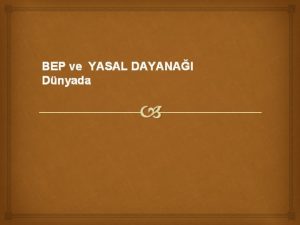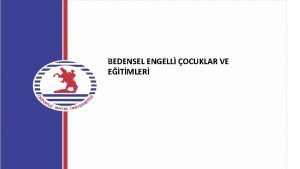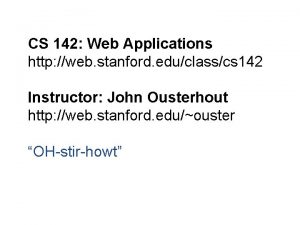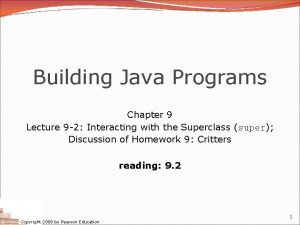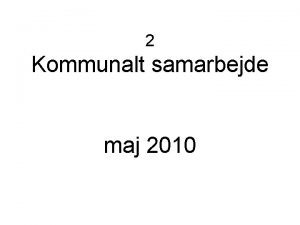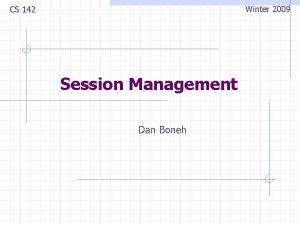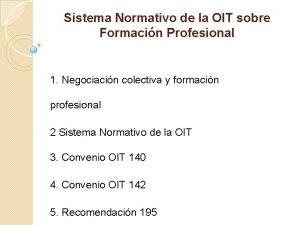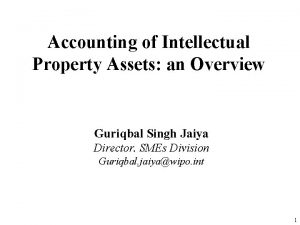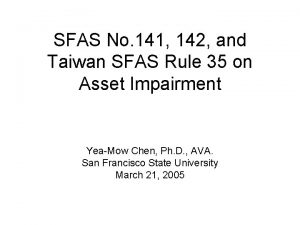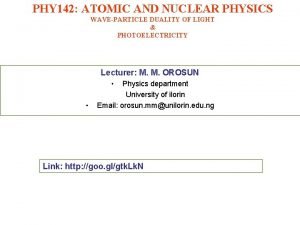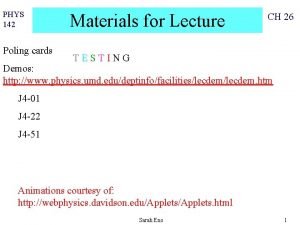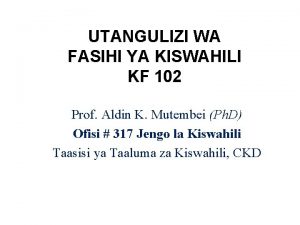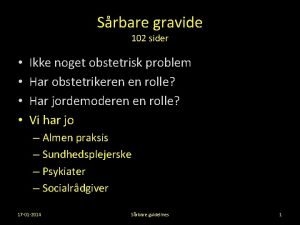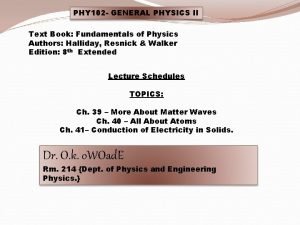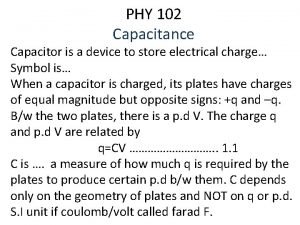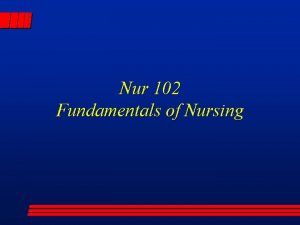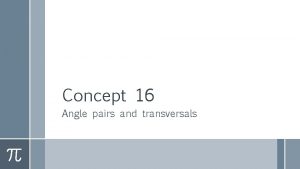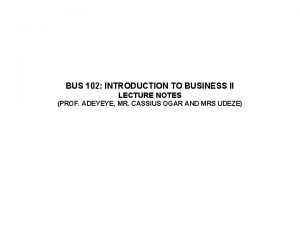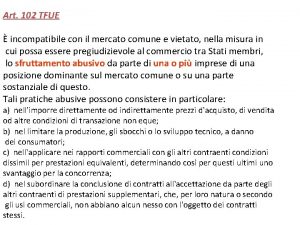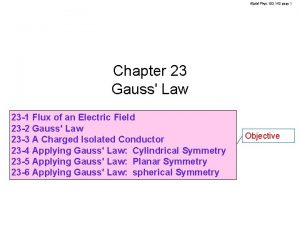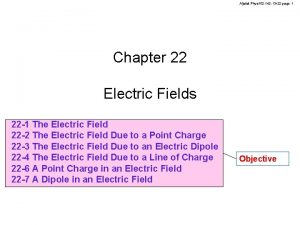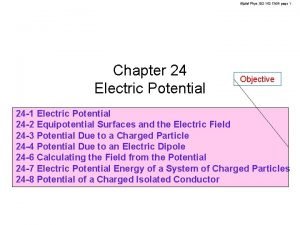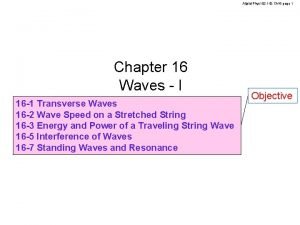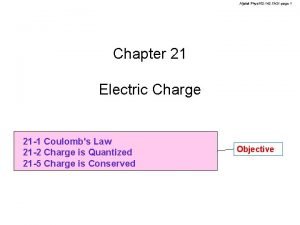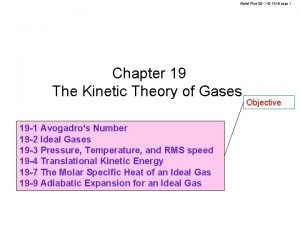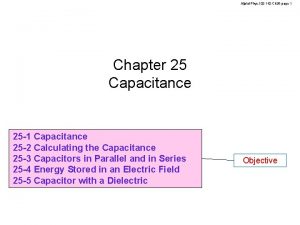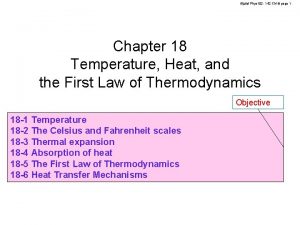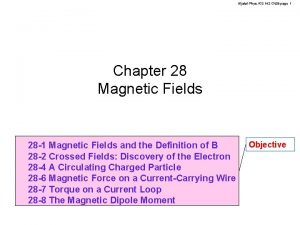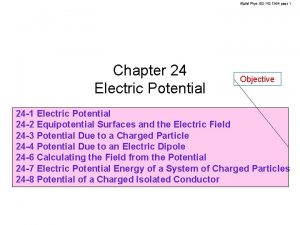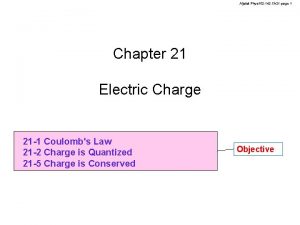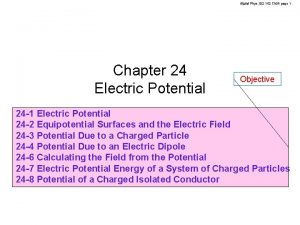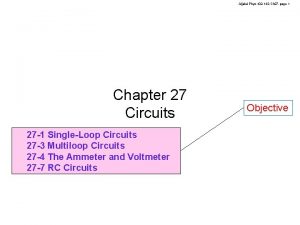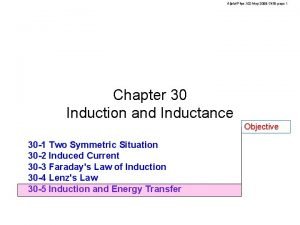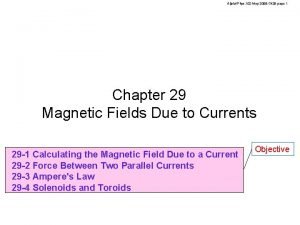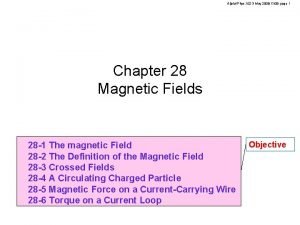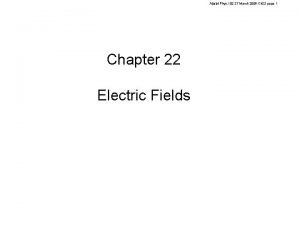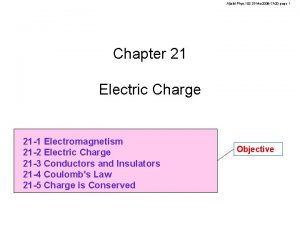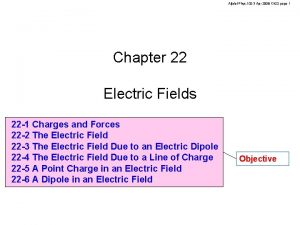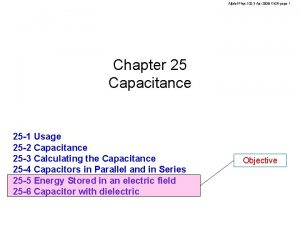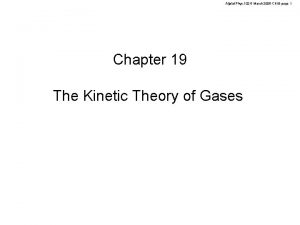AljalalPhys 102 142 Ch 30 page 1 Chapter








































- Slides: 40

Aljalal-Phys. 102 -142 -Ch 30 -page 1 Chapter 30 Induction and Inductance Objective 30 -1 Faraday's Law and Lenz's Law 30 -2 Induction and Energy Transfers

Aljalal-Phys. 102 -142 -Ch 30 -page 2 30 -1 Faraday's Law and Lenz's Law Electric motor and electric generator Electric motor i i Get rotation Electric generator Put current loop + magnetic field = torque Get Rotate current torque + magnetic field = current

Aljalal-Phys. 102 -142 -Ch 30 -page 3 30 -1 Faraday's Law and Lenz's Law Relative motion Stationary magnet Wire Magnet in motion Wire Ammeter No current Magnet in motion Wire Ammeter Current in one direction Ammeter Current in the other direction A current appears only if there is a relative motion between the loop and the magnet.

Aljalal-Phys. 102 -142 -Ch 30 -page 4 30 -1 Faraday's Law and Lenz's Law Speed of motion Magnet in slow motion Wire Magnet in fast motion Wire Ammeter Small current Ammeter Large current Faster motion produces a larger current.

Aljalal-Phys. 102 -142 -Ch 30 -page 5 30 -1 Faraday's Law and Lenz's Law Direction of magnet Magnet in motion Wire Ammeter Current in one direction Ammeter Current in the other direction If the magnet is reversed, the current is also reversed.

30 -1 Faraday's Law and Lenz's Law Induction Aljalal-Phys. 102 -142 -Ch 30 -page 6 Magnet in motion Induced emf work done per unit charge to produce an induced current. Induced current Wire Ammeter Induction process of producing an induced current and an emf.

Aljalal-Phys. 102 -142 -Ch 30 -page 7 30 -1 Faraday's Law and Lenz's Law Closing a switch Switch has been open for a long time. Wire Just after closing the switch, Wire Ammeter No current in the blue coil Ammeter Current briefly appears in the blue coil.

Aljalal-Phys. 102 -142 -Ch 30 -page 8 30 -1 Faraday's Law and Lenz's Law Opening a switch Switch has been closed for a long time. Wire Just after opening the switch, Wire Ammeter No current in the blue coil Ammeter Current briefly appears in the blue coil.

Aljalal-Phys. 102 -142 -Ch 30 -page 9 30 -1 Faraday's Law and Lenz's Law Induced emf and magnetic field lines Magnet in motion Wire Just after closing or opening the switch Wire Ammeter An emf induced in a loop when the number of magnetic field lines that passes through the loop is changing. The value of the induced emf is determined by the rate at which the number of magnetic field lines changes.

30 -1 Faraday's Law and Lenz's Law Magnetic field lines of a magnet through a wire loop Magnet in motion Wire Aljalal-Phys. 102 -142 -Ch 30 -page 10 Magnet in motion Wire Ammeter The number of magnetic field lines is increasing. Ammeter The number of magnetic field lines is decreasing.

Aljalal-Phys. 102 -142 -Ch 30 -page 11 30 -1 Faraday's Law and Lenz's Law Magnetic field lines of a wire loop through another wire loop Just after closing the switch, Wire Just after opening the switch, Wire Ammeter The number of magnetic field lines is increasing. Ammeter The number of magnetic field lines is decreasing.

30 -1 Faraday's Law and Lenz's Law Formula - Magnetic flux Aljalal-Phys. 102 -142 -Ch 30 -page 12 Magnetic flux through area A Integration over the area A Area vector Magnitude: area of d. A Direction: perpendicular to area d. A

Aljalal-Phys. 102 -142 -Ch 30 -page 13 30 -1 Faraday's Law and Lenz's Law Magnetic flux: special case Uniform magnetic field Loop lies in a plane perpendicular to the magnetic field Magnetic Flux through the loop For a uniform magnetic field normal to a loop

30 -1 Faraday's Law and Lenz's Law SI unit for magnetic flux FB Weber Symbol Wb Aljalal-Phys. 102 -142 -Ch 30 -page 14

30 -1 Faraday's Law and Lenz's Law Formula - Faraday's law of induction Aljalal-Phys. 102 -142 -Ch 30 -page 15 Faraday's Law Induced emf tends to oppose the flux change

30 -1 Faraday's Law and Lenz's Law N-turn loop One-turn loop Aljalal-Phys. 102 -142 -Ch 30 -page 16 Loop of N turns Total emf is the sum of individual induced emf.

30 -1 Faraday's Law and Lenz's Law Ways of changing magnetic flux Aljalal-Phys. 102 -142 -Ch 30 -page 17 Magnetic flux through a loop can be changed by changing the magnitude of the magnetic field or changing the size of the loop in the magnetic field or changing the angle between the magnetic field and the loop.

30 -1 Faraday's Law and Lenz's Law Checkpoint 1 Rank the time intervals according to the magnitude of the emf induced in a conducting loop perpendicular to B, greatest first. Aljalal-Phys. 102 -142 -Ch 30 -page 18 uniform magnetic field Solution Slope of B-t curve b, then d and e tie, then a and c tie.

30 -1 Faraday's Law and Lenz's Law Example 1 Aljalal-Phys. 102 -142 -Ch 30 -page 19 Current in the solenoid is reduced at steady rate from 10 A to zero in 25 ms. What is the emf induced in coil C? Solution Flux through coil C Long Solenoid S 220 turns/cm Number of turns of coil C Produced by Solenoid S Cross sectional area of coil C Number of turns per unit length of the solenoid S Coil C 130 -trun coil

30 -1 Faraday's Law and Lenz's Law Example 1 Aljalal-Phys. 102 -142 -Ch 30 -page 20 Solution Current in the solenoid is reduced at steady rate from 10 A to zero in 25 ms. Long Solenoid S 220 turns/cm Coil C 130 -trun coil

30 -1 Faraday's Law and Lenz's Law Direction of induced current Aljalal-Phys. 102 -142 -Ch 30 -page 21 An induced current has a direction such that the magnetic field due to the current opposes the change in the magnetic flux that induces the current. Induced emf tends to oppose the flux change

30 -1 Faraday's Law and Lenz's Law Illustration - North pole approaching a wire loop Magnet in motion Aljalal-Phys. 102 -142 -Ch 30 -page 22 Induced Bind opposes the change in the flux. Wire Ammeter The number of magnetic field lines is increasing Increasing B Induced current Use the right-hand rule to find the direction of the current.

Aljalal-Phys. 102 -142 -Ch 30 -page 23 30 -1 Faraday's Law and Lenz's Law Illustration - North pole moving away from a wire loop Magnet in motion Induced Bind opposes the change in the flux. Wire Ammeter The number of magnetic field lines is decreasing Decreasing B Induced current Use the right-hand rule to find the direction of the current.

30 -1 Faraday's Law and Lenz's Law Illustration - South pole approaching a wire loop Magnet in motion Aljalal-Phys. 102 -142 -Ch 30 -page 24 Induced Bind opposes the change in the flux. Increasing B Wire Ammeter The number of magnetic field lines is increasing Induced current Use the right-hand rule to find the direction of the current.

Aljalal-Phys. 102 -142 -Ch 30 -page 25 30 -1 Faraday's Law and Lenz's Law Illustration - South pole moving away from a wire loop Magnet in motion Induced Bind opposes the change in the flux. Decreasing B Wire Ammeter The number of magnetic field lines is decreasing Induced current Use the right-hand rule to find the direction of the current.

30 -1 Faraday's Law and Lenz's Law Illustration - Closing a switch Just after closing the switch, Aljalal-Phys. 102 -142 -Ch 30 -page 26 Induced Bind opposes the change in the flux. Increasing B Wire Ammeter the number of magnetic field lines is increasing. Induced current Use the right-hand rule to find the direction of the current.

30 -1 Faraday's Law and Lenz's Law Illustration - Opening a switch Just after opening the switch Aljalal-Phys. 102 -142 -Ch 30 -page 27 Induced Bind opposes the change in the flux. Decreasing B Wire Ammeter the number of magnetic field lines is decreasing Induced current Use the right-hand rule to find the direction of the current.

Aljalal-Phys. 102 -142 -Ch 30 -page 28 30 -1 Faraday's Law and Lenz's Law Checkpoint 2 Rank according to the magnitude of the current induced in the loop, greatest first. Magnetic fields change at identical rates Increasing B Solution a and b tie, then c (zero) Decreasing B

30 -1 Faraday's Law and Lenz's Law Uniform Example 2 magnetic field B in Tesla and t in seconds r = 0. 2 m Resistance of the loop R = 2. 0 W Solution Aljalal-Phys. 102 -142 -Ch 30 -page 29

30 -1 Faraday's Law and Lenz's Law Uniform Example 2 - continuation magnetic field Solution At 10 s, Flux is increasing. Aljalal-Phys. 102 -142 -Ch 30 -page 30

30 -1 Faraday's Law and Lenz's Law Uniform Example 2 - continuation magnetic field Resistance of the loop R= 2. 0 W What is the current in the loop at t = 10 s? Solution Aljalal-Phys. 102 -142 -Ch 30 -page 31

30 -1 Faraday's Law and Lenz's Law Example 3 B = 4 t 2 x 2 B in Tesla and t in seconds W = 3. 0 m H = 2. 0 m B is normal to the loop Solution Aljalal-Phys. 102 -142 -Ch 30 -page 32 Non-uniform magnetic field Loop

30 -1 Faraday's Law and Lenz's Law Example 3 - continuation Solution At 0. 10 s, Flux is increasing. Aljalal-Phys. 102 -142 -Ch 30 -page 33

Aljalal-Phys. 102 -142 -Ch 30 -page 34 30 -2 Induction and Energy Transfers Formula - Mechanical and thermal powers Work that you do to pull a conducting loop out of a uniform magnetic field appears as thermal energy in the loop. Uniform magnetic field You pull at a constant velocity Conducting loop Rate at which work is done (power) to pull a loop out of a uniform magnetic field Fapp v = i 2 R Rate at which thermal energy is dissipated in the loop

Aljalal-Phys. 102 -142 -Ch 30 -page 35 30 -2 Induction and Energy Transfers Induced emf while pulling a wire loop out of a magnetic field We will show Fapp v = i 2 R Conducting loop Induced emf

Aljalal-Phys. 102 -142 -Ch 30 -page 36 30 -2 Induction and Energy Transfers Induced current while pulling a wire loop out of a magnetic field We will show Fapp v = i 2 R Conducting loop Induced current Collective resistance of the wire

Aljalal-Phys. 102 -142 -Ch 30 -page 37 30 -2 Induction and Energy Transfers Mechanical power on a wire loop moving out of a magnetic field We will show Fapp v = i 2 R Induced current To pull at constant velocity, Balance each other Work that you do to pull a conducting loop out of a uniform magnetic field appears as thermal energy in the loop.

Aljalal-Phys. 102 -142 -Ch 30 -page 38 30 -2 Induction and Energy Transfers Opposing force while pushing a magnet into a wire loop Magnet in motion Wire Magnet in motion Opposing force from the induced magnetic field Opposing force Loop acts like a magnet Ammeter Whenever you move a magnet toward a conducting closed loop, a magnetic force resists the motion, requiring you to do positive work The energy you transfer to the system (magnet + loop), appears as thermal energy in the loop.

Aljalal-Phys. 102 -142 -Ch 30 -page 39 30 -2 Induction and Energy Transfers Opposing force while pulling a magnet away from a wire loop Magnet in motion Wire Magnet in motion Opposing force from the induced magnetic field Opposing force Loop acts like a magnet Ammeter Whenever you move a magnet away from a conducting closed loop, a magnetic force resists the motion, requiring you to do positive work The energy you transfer to the system (magnet + loop), appears as thermal energy in the loop.

30 -2 Induction and Energy Transfers Checkpoint 3 Aljalal-Phys. 102 -142 -Ch 30 -page 40 Loops with edge lengths either L or 2 L, move at the same constant speed. Rank according to the maximum magnitude of the emf induced in the loops as the loops move into the magnetic field, greatest first. Uniform magnetic field Solution c and d tie, then a and b tie.
 Apa title paper
Apa title paper Prime numbers up to 200
Prime numbers up to 200 Pl94-142
Pl94-142 P.l 94-142
P.l 94-142 Ejercicios con numeros romanos
Ejercicios con numeros romanos Cs142 stanford
Cs142 stanford Psalms 142 meaning
Psalms 142 meaning Math 142 asu
Math 142 asu 5600 in scientific notation
5600 in scientific notation Phm142
Phm142 Java critter strategy
Java critter strategy Generel helbredsattest eksempel
Generel helbredsattest eksempel Stanford cs 142
Stanford cs 142 Convenio 142 oit
Convenio 142 oit Sfas 142
Sfas 142 Fasb 142
Fasb 142 Physics 142
Physics 142 Dicom supplement 142
Dicom supplement 142 Phys 142
Phys 142 12 742 km in miles
12 742 km in miles 142 cooper river drive
142 cooper river drive 100000/142
100000/142 Fitness chapter 102
Fitness chapter 102 Physics 102 electricity and magnetism
Physics 102 electricity and magnetism Phys 102 uiuc
Phys 102 uiuc Mifumo mbalimbali ya fasihi
Mifumo mbalimbali ya fasihi Servicelovens 102
Servicelovens 102 Convenio 102
Convenio 102 Psalm 28 niv
Psalm 28 niv Psalm 102:25
Psalm 102:25 Physics 102
Physics 102 102 capacitor
102 capacitor Nur 102
Nur 102 Met 102
Met 102 Renton technical college renton wa
Renton technical college renton wa Csc 102 pdf
Csc 102 pdf Alternate exter angles
Alternate exter angles Convenio 102
Convenio 102 Introduction to business notes
Introduction to business notes 102 tfue
102 tfue 657 sayılı kanun 102. madde
657 sayılı kanun 102. madde


